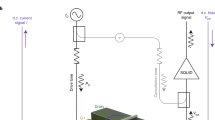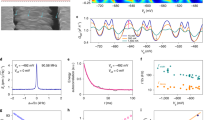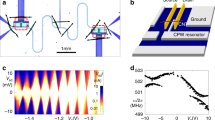Abstract
The behaviour of traditional electronic devices can be understood in terms of the classical diffusive motion of electrons. As the size of a device becomes comparable to the electron coherence length, however, quantum interference between electron waves becomes increasingly important, leading to dramatic changes in device properties1,2,3,4,5,6,7,8. This classical-to-quantum transition in device behaviour suggests the possibility for nanometer-sized electronic elements that make use of quantum coherence1,2,7,8. Molecular electronic devices are promising candidates for realizing such device elements because the electronic motion in molecules is inherently quantum mechanical9,10 and it can be modified by well defined chemistry11,12,13. Here we describe an example of a coherent molecular electronic device whose behaviour is explicitly dependent on quantum interference between propagating electron waves—a Fabry–Perot electron resonator based on individual single-walled carbon nanotubes with near-perfect ohmic contacts to electrodes. In these devices, the nanotubes act as coherent electron waveguides14,15,16, with the resonant cavity formed between the two nanotube–electrode interfaces. We use a theoretical model based on the multichannel Landauer–Büttiker formalism17,18,19 to analyse the device characteristics and find that coupling between the two propagating modes of the nanotubes caused by electron scattering at the nanotube–electrode interfaces is important.
This is a preview of subscription content, access via your institution
Access options
Subscribe to this journal
Receive 51 print issues and online access
$199.00 per year
only $3.90 per issue
Buy this article
- Purchase on Springer Link
- Instant access to full article PDF
Prices may be subject to local taxes which are calculated during checkout




Similar content being viewed by others
References
Ando, T. et al. Mesoscopic Physics and Electronics (Springer, Berlin, 1998).
Datta, S. Electronic Transport in Mesoscopic Systems (Cambridge Univ. Press, Cambridge, 1995).
van Wees, B. J. et al. Observation of zero-dimensional states in a one-dimensional electron interferometer. Phys. Rev. Lett. 62, 2523–2526 (1989).
Crommie, M., Lutz, C. P. & Eigler, D. M. Confinement of electrons to quantum corrals on a metal surface. Science 262, 218–220 (1993).
Ji, Y. et al. Phase evolution in a Kondo-correlated system. Science 290, 779–783 (2000).
Topinka, M. A. et al. Imaging coherent electron flow from a quantum point contact. Science 289, 2323–2326 (2000).
Manoharan, H. C., Lutz, C. P. & Eigler, D. M. Quantum mirages formed by coherent projection of electronic structure. Nature 403, 512–515 (2000).
Debray, P. et al. Ballistic electron transport in stubbed quantum waveguides: Experiment and theory. Phys. Rev. B 61, 10950–10958 (2000).
Joachim, C., Gimzewski, J. K. & Aviram, A. Electronics using hybrid-molecular and mono-molecular devices. Nature 408, 541–548 (2000).
Park, H. et al. Nano-mechanical oscillations in a single-C60 transistor. Nature 407, 57–60 (2000).
Chen, J., Reed, M. A., Rawlett, A. M. & Tour, J. M. Large on-off ratios and negative differential resistance in a molecular electronic device. Nature 286, 1550–1552 (1999).
Collier, C. P. et al. A [2]catenane-based solid state electronically reconfigurable switch. Science 289, 1172–1175 (2000).
Bockrath, M. et al. Resonant electron scattering by defects in single-walled carbon nanotubes. Science 291, 283–285 (2001).
White, C. T. & Todorov, T. N. Carbon nanotubes as long ballistic conductors. Nature 393, 240–242 (1998).
Frank, S., Poncharal, P., Wang, Z. L. & De Heer, W. A. Carbon nanotube quantum resistors. Science 280, 1744–1746 (1998).
Dekker, C. Carbon nanotubes as molecular quantum wires. Phys. Today 52 (5), 22–28 (1999).
Büttiker, M., Imry, Y., Landauer, R. & Pinhas, S. Generalized many-channel conductance formula with application to small rings. Phys. Rev. B 31, 6207–6215 (1985).
Büttiker, M. Role of quantum coherence in series resistors. Phys. Rev. B 33, 3020–3026 (1986).
Cahay, M., McLennan, M. & Datta, S. Conductance of an array of elastic scatterers: A scattering-matrix approach. Phys. Rev. B 37, 10125–10136 (1988).
Tans, S. J., Verschueren, A. R. M. & Dekker, C. Room-temperature transistor based on a single carbon nanotube. Nature 393, 49–52 (1998).
McEuen, P. L. et al. Disorder, pseudospins, and backscattering in carbon nanotubes. Phys. Rev. Lett. 83, 5098–5101 (1999).
Bockrath, M. et al. Single-electron transport in ropes of carbon nanotubes. Science 275, 1922–1925 (1997).
Tans, S. J. et al. Individual single-wall carbon nanotubes as quantum wires. Nature 386, 474–476 (1997).
Tans, S. J., Devoret, M. H., Groeneveld, R. J. A. & Dekker, C. Electron–electron correlations in carbon nanotubes. Nature 394, 761–764 (1998).
Nygard, J., Cobden, D. H. & Lindelof, P. E. Kondo physics in carbon nanotubes. Nature 408, 342–346 (2000).
Venema, L. C. et al. Imaging electron wave functions of quantized energy levels in carbon nanotubes. Science 283, 52–55 (1999).
Bachtold, A. et al. Aharonov-Bohm oscillations in carbon nanotubes. Nature 397, 673–675 (1999).
Tsukagoshi, K., Alphenaar, B. W. & Ago, H. Coherent transport of electron spin in a ferromagnetically contacted carbon nanotube. Nature 401, 572–574 (1999).
Hecht, E. Optics (Addison-Wesley, Reading, 1987).
Sohn, L. L., Kouwenhoven, L. P. & Schön, G. Mesoscopic Electron Transport (Kluwer, Dordrecht, 1997).
Acknowledgements
We thank C. M. Lieber for providing facilities to synthesize SWNTs; and C. M. Lieber, B. I. Halperin, E. J. Heller and C. Marcus for discussions and advice. This work is supported by NSF and ONR (M.T.) and the Dreyfus Foundation, NSF, and Harvard University (H.P.). J.H.H. was supported by NIH.
Author information
Authors and Affiliations
Corresponding author
Rights and permissions
About this article
Cite this article
Liang, W., Bockrath, M., Bozovic, D. et al. Fabry - Perot interference in a nanotube electron waveguide. Nature 411, 665–669 (2001). https://doi.org/10.1038/35079517
Received:
Accepted:
Published:
Issue Date:
DOI: https://doi.org/10.1038/35079517
This article is cited by
-
Observation of electronic modes in open cavity resonator
Nature Communications (2023)
-
Effective lifting of the topological protection of quantum spin Hall edge states by edge coupling
Nature Communications (2022)
-
An epitaxial graphene platform for zero-energy edge state nanoelectronics
Nature Communications (2022)
-
HOT Graphene and HOT Graphene Nanotubes: New Low Dimensional Semimetals and Semiconductors
Nanoscale Research Letters (2020)
-
Suspended superconducting weak links from aerosol-synthesized single-walled carbon nanotubes
Nano Research (2020)
Comments
By submitting a comment you agree to abide by our Terms and Community Guidelines. If you find something abusive or that does not comply with our terms or guidelines please flag it as inappropriate.



